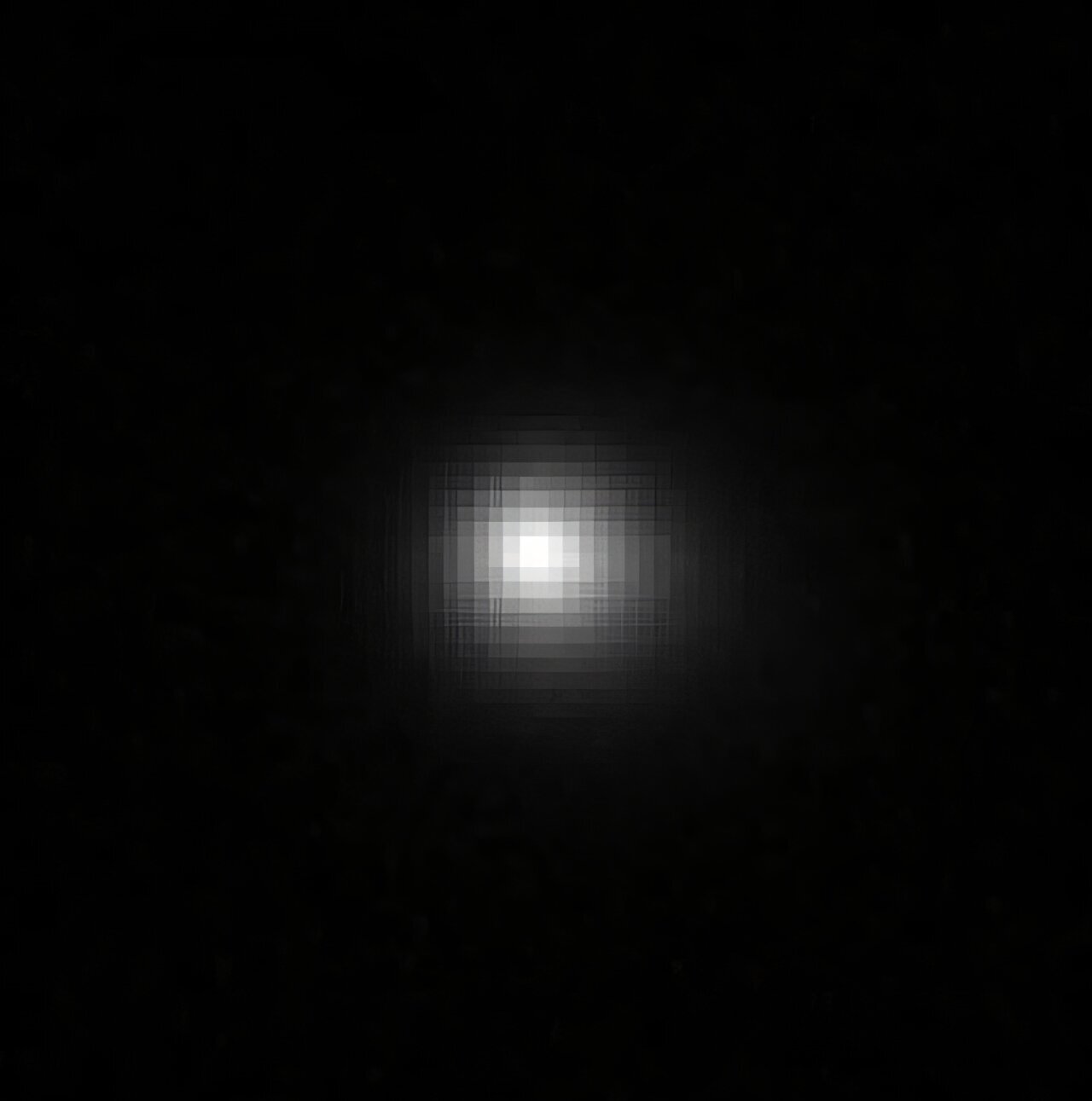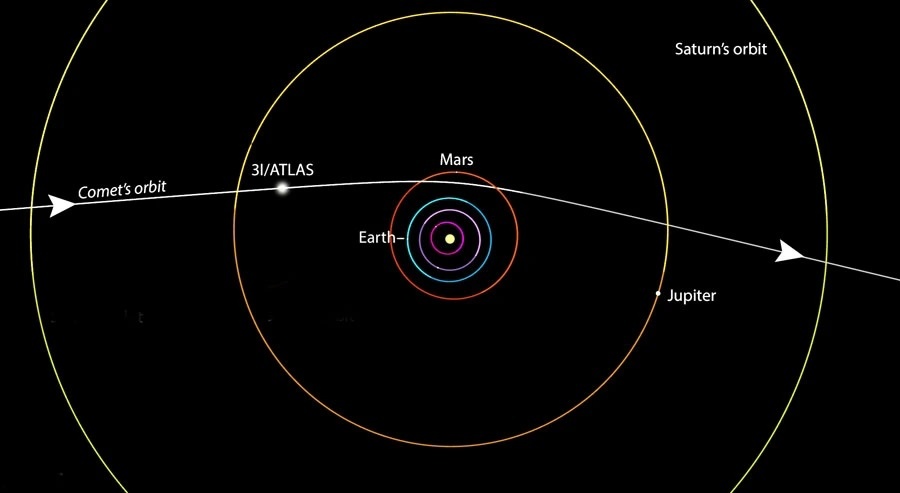29.07.2025
INTERSTELLAR COMET 3I/ATLAS: WHAT WE KNOW NOW
Observations have revealed the comet’s fuzzy coma, hinted at a weird tail, and suggested an ancient history. Plus, some missions might keep observing the interstellar comet when it ducks behind the Sun.
INTERSTELLARER KOMET 3I/ATLAS: WAS WIR JETZT WISSEN
Beobachtungen haben die unscharfe Koma des Kometen enthüllt, einen seltsamen Schweif angedeutet und eine uralte Geschichte nahegelegt. Darüber hinaus könnten einige Missionen den interstellaren Kometen weiter beobachten, wenn er hinter der Sonne verschwindet.
Telescopes on Earth and above it have their eyes on the third-ever interstellar object ever seen inside our solar system, Comet 3I/ATLAS. Already, telescopes including the 8.4-meter Vera C. Rubin Observatory, the Very Large Telescope, and the Gemini South telescope have spent time on the object. Just last week, the Hubble Space Telescope joined in, and the James Webb Space Telescope is expected to do so in the coming days.
This unusual comet is the second extrasolar comet ever seen, after Comet 2I/Borisov, found in 2019. (The first interstellar object, 1I/ ‘Oumuamua, didn’t appear to be a comet.) 3I/ATLAS is zooming through the solar system far faster than either of the previous interstellar objects and, also unlike them, is on a trajectory very close to the ecliptic — tilted less than 5° from the plane of the solar system’s planets.
THE COMA
Bryce Bolin (Eureka Scientific), lead author of one of the first papers detailing what we know about 3I/ATLAS, after its discovery by Larry Denneau (University of Hawai‘i), has been observing the object using multiple telescopes, including the Palomar Observatory.
“We were able to determine that the comet had a coma about two or three arcseconds wide,” Bolin says. Some observers questioned whether these images showed a true coma or merely a smearing due to the object’s motion, but a new paper, posted last week on the astronomy arXiv preprint server by Colin Chandler (University of Washington) and collaborators, came to a similar conclusion using the observations from the Rubin Observatory.
The Rubin team realized that their telescope had — unbeknownst to them — imaged the object starting 10 days before its discovery. From more than 100 images taken over the ensuing two weeks, the researchers found that the apparent coma grew slightly during that period. The team estimated from those images that the nucleus spans at most 11.4 km (7 miles).
Although there is no formal size estimate in the earlier Bolin et al. paper, Bolin says he estimates it’s even smaller, in the range of 0.5 to 1 km. Bolin’s team’s smaller size estimate is consistent with predictions made by Avi Loeb (Harvard University), based on the statistics of interstellar objects that have been observed so far. If 3I/ATLAS were much larger than that, Loeb argued, that would imply a much greater population of smaller interstellar comets, which should have been observed by now if they existed.
THE TAIL
The Rubin observations also show hints of a dusty tail, but oddly this elongation points directly toward the Sun. Typically, the push of the Sun’s radiation moves dust in comet’s tails so that it points away from the Sun. Bolin suggests that this may indicate “that massive particles are being ejected in the solar direction, and they’re too heavy to be blown by the solar radiation at the distance the comet is from the Sun, so they’re continuing to go forward a little bit toward the Sun.”
THE ORIGIN
Comet 3I/ATLAS’s origin is still mysterious. However, a new analysis by Matthew Hopkins (University of Oxford, UK) and colleagues suggests that the object might have come from the Milky Way’s thick disk, our galaxy’s vertically extended disk of older stars.
Hopkins’ team arrives at this conclusion by comparing the steep incoming trajectory to the expected orbits of interstellar objects in the Milky Way. If the finding pans out, it would make 3I/ATLAS the oldest comet ever seen, as much as 7 billion years old — even more ancient than the solar system itself.
THE TRAJECTORY
As Comet 3I/ATLAS continues on its way, it will pass relatively close to Jupiter (0.36 au), Mars (1.5 au), and Venus (0.7 au), but its closest approach to Earth later this year is farther away, at 1.8 au. It’ll therefore be relatively faint in our skies come December.
Moreover, when the comet reaches its closest approach to the Sun, or perihelion, it will be almost directly behind the Sun as seen from Earth. That will prevent Earth-based observations just when interesting behavior might be occurring. For example, Comet 2I/Borisov shed a small fragment at about the time of its perihelion passage; such fragmentation around perihelion is not uncommon among comets.
But while the comet will be hidden from Earth’s view around perihelion — even the Hubble and Webb space telescopes can’t point near it during that period because it will be too close to the Sun’s glare — other spacecraft might fill the gap.
CAPTURING THE COMET AT PERIHELION
Marshall Eubanks (Space Initiatives Inc.) has calculated that several interplanetary spacecraft as well as Mars orbiters or rovers could have a clear view of 3I/ATLAS while it’s out of Earth’s view. He has been communicating with members of the teams managing these missions.
The two best candidates, Eubanks tells Sky & Telescope, are the Jupiter Icy Moons Explorer (JUICE), and Psyche, which is on its way to the asteroid of the same name. JUICE, he says, “will have a wonderful view of 3I,” from less than a third of an astronomical unit (au) away (about 10 times closer than the comet’s distance from Earth at that time), and has some instruments that could do useful observations. But making a sudden change in such an expensive mission, which has been many years in planning and development, is far from trivial. Any changes would have to be developed carefully to avoid endangering the primary mission, and no decision has been made yet by that team.
Psyche will be similarly well placed, about 0.4 au away from 3I/ATLAS. But it’s under steady propulsion from its ion drive, which might make observing the comet tricky. Robotic observers at or around Mars might have an easier time making the adjustments needed to make useful observations, Eubanks says.
One way or another, it would be useful to have observational coverage of the comet’s entire journey through the solar system. Astronomers still regret that there were such limited observations of the two previous interstellar objects, because their discoveries occurred relatively late in their solar system passes.
This time, continuous coverage could capture unusual activity takes place such as fragmentaion. As Eubanks says, “it would be very nice to be able to observe that in real time, as opposed to just trying to guess what happened afterwards.”
Quelle: Sky&Telescope
+
Teleskope auf der Erde und darüber haben das dritte interstellare Objekt, das jemals in unserem Sonnensystem beobachtet wurde, im Visier: den Kometen 3I/ATLAS. Teleskope wie das 8,4-Meter-Observatorium Vera C. Rubin, das Very Large Telescope und das Gemini South-Teleskop haben bereits einige Zeit mit dem Objekt verbracht. Erst letzte Woche kam das Hubble-Weltraumteleskop dazu, und das James-Webb-Weltraumteleskop wird in den kommenden Tagen folgen.
Dieser ungewöhnliche Komet ist nach dem 2019 entdeckten Kometen 2I/Borisov der zweite jemals beobachtete extrasolare Komet. (Das erste interstellare Objekt, 1I/ ‚Oumuamua, schien kein Komet zu sein.) 3I/ATLAS rast deutlich schneller durch das Sonnensystem als die beiden vorherigen interstellaren Objekte und befindet sich im Gegensatz zu diesen auf einer Bahn, die sehr nahe an der Ekliptik liegt – weniger als 5° von der Ebene der Planeten des Sonnensystems geneigt.
DIE KOMA
Bryce Bolin (Eureka Scientific), Hauptautor einer der ersten Arbeiten, die unser Wissen über 3I/ATLAS nach seiner Entdeckung durch Larry Denneau (University of Hawaii) detailliert darlegt, hat das Objekt mit mehreren Teleskopen, darunter dem Palomar-Observatorium, beobachtet.
„Wir konnten feststellen, dass der Komet eine Koma von etwa zwei bis drei Bogensekunden Breite hat“, sagt Bolin. Einige Beobachter bezweifelten, dass diese Bilder eine echte Koma oder lediglich eine durch die Bewegung des Objekts verursachte Verschmierung zeigten, doch ein neues Papier, das letzte Woche auf dem Astronomie-Preprint-Server arXiv von Colin Chandler (University of Washington) und seinen Mitarbeitern veröffentlicht wurde, kam anhand der Beobachtungen des Rubin-Observatoriums zu einem ähnlichen Schluss.
Das Rubin-Team erkannte, dass ihr Teleskop das Objekt – ohne ihr Wissen – bereits zehn Tage vor seiner Entdeckung abgebildet hatte. Anhand von über 100 Bildern, die in den darauffolgenden zwei Wochen aufgenommen wurden, fanden die Forscher heraus, dass die scheinbare Koma in diesem Zeitraum leicht zunahm. Das Team schätzte anhand dieser Bilder, dass der Kern höchstens 11,4 km (7 Meilen) misst.
Obwohl die frühere Arbeit von Bolin et al. keine formelle Größenschätzung enthält, schätzt Bolin den Wert nach eigenen Angaben sogar noch kleiner, im Bereich von 0,5 bis 1 km. Die geringere Größenschätzung von Bolins Team steht im Einklang mit Vorhersagen von Avi Loeb (Harvard University), die auf der Statistik bisher beobachteter interstellarer Objekte basieren. Wäre 3I/ATLAS viel größer, argumentierte Loeb, würde dies eine viel größere Population kleinerer interstellarer Kometen bedeuten, die, wenn sie existierten, inzwischen hätten beobachtet werden müssen.
DER SCHWEIF
Die Rubin-Beobachtungen zeigen ebenfalls Hinweise auf einen staubigen Schweif, doch seltsamerweise zeigt diese Verlängerung direkt zur Sonne. Typischerweise bewegt der Druck der Sonnenstrahlung den Staub im Kometenschweif so, dass er von der Sonne weg zeigt. Bolin vermutet, dass dies darauf hindeuten könnte, „dass massive Partikel in Richtung Sonne ausgestoßen werden. Diese sind zu schwer, um in der Entfernung des Kometen von der Sonne von der Sonnenstrahlung weggetragen zu werden. Daher bewegen sie sich weiterhin ein Stück weit in Richtung Sonne.“
DER URSPRUNG
Der Ursprung des Kometen 3I/ATLAS ist noch immer rätselhaft. Eine neue Analyse von Matthew Hopkins (Universität Oxford, Großbritannien) und Kollegen legt jedoch nahe, dass das Objekt aus der dicken Scheibe der Milchstraße stammen könnte, der vertikal ausgedehnten Scheibe älterer Sterne unserer Galaxie.
Hopkins‘ Team gelangt zu dieser Schlussfolgerung, indem es die steile Anflugbahn mit den erwarteten Umlaufbahnen interstellarer Objekte in der Milchstraße vergleicht. Sollte sich dieser Befund bewahrheiten, wäre 3I/ATLAS der älteste jemals beobachtete Komet, mit einem Alter von bis zu 7 Milliarden Jahren – und damit älter als das Sonnensystem selbst.
DIE FLUGBAHN
As Comet 3I/ATLAS continues on its way, it will pass relatively close to Jupiter (0.36 au), Mars (1.5 au), and Venus (0.7 au), but its closest approach to Earth later this year is farther away, at 1.8 au. It’ll therefore be relatively faint in our skies come December.
Moreover, when the comet reaches its closest approach to the Sun, or perihelion, it will be almost directly behind the Sun as seen from Earth. That will prevent Earth-based observations just when interesting behavior might be occurring. For example, Comet 2I/Borisov shed a small fragment at about the time of its perihelion passage; such fragmentation around perihelion is not uncommon among comets.
But while the comet will be hidden from Earth’s view around perihelion — even the Hubble and Webb space telescopes can’t point near it during that period because it will be too close to the Sun’s glare — other spacecraft might fill the gap.
CAPTURING THE COMET AT PERIHELION
Marshall Eubanks (Space Initiatives Inc.) has calculated that several interplanetary spacecraft as well as Mars orbiters or rovers could have a clear view of 3I/ATLAS while it’s out of Earth’s view. He has been communicating with members of the teams managing these missions.
The two best candidates, Eubanks tells Sky & Telescope, are the Jupiter Icy Moons Explorer (JUICE), and Psyche, which is on its way to the asteroid of the same name. JUICE, he says, “will have a wonderful view of 3I,” from less than a third of an astronomical unit (au) away (about 10 times closer than the comet’s distance from Earth at that time), and has some instruments that could do useful observations. But making a sudden change in such an expensive mission, which has been many years in planning and development, is far from trivial. Any changes would have to be developed carefully to avoid endangering the primary mission, and no decision has been made yet by that team.
Psyche will be similarly well placed, about 0.4 au away from 3I/ATLAS. But it’s under steady propulsion from its ion drive, which might make observing the comet tricky. Robotic observers at or around Mars might have an easier time making the adjustments needed to make useful observations, Eubanks says.
One way or another, it would be useful to have observational coverage of the comet’s entire journey through the solar system. Astronomers still regret that there were such limited observations of the two previous interstellar objects, because their discoveries occurred relatively late in their solar system passes.
This time, continuous coverage could capture unusual activity takes place such as fragmentaion. As Eubanks says, “it would be very nice to be able to observe that in real time, as opposed to just trying to guess what happened afterwards.”
Quelle: Sky&Telescope
